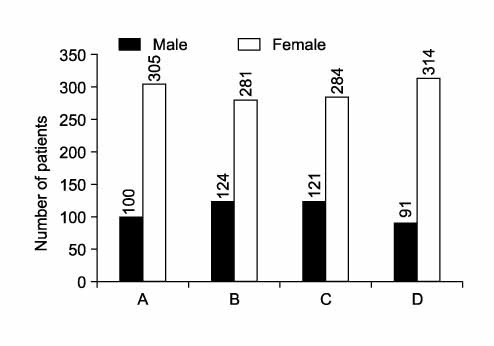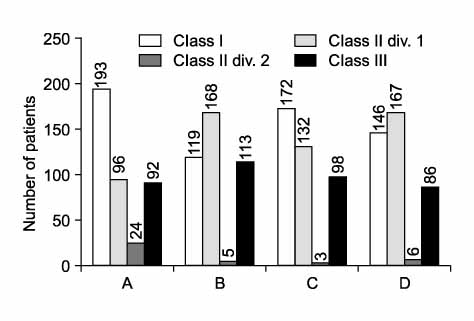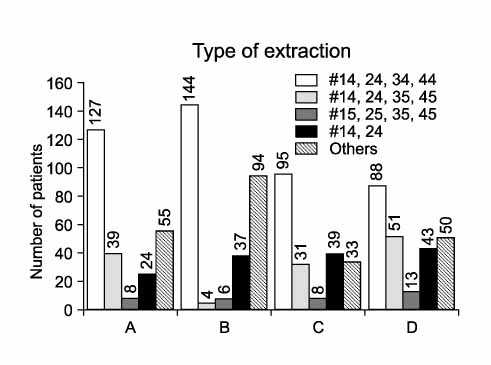Current trends in orthodontic patients in private orthodontic clinics
- Affiliations
-
- 1Department of Orthodontics, Seoul National University Dental Hospital, Korea. fortit@chol.com
- KMID: 1469137
- DOI: http://doi.org/10.4041/kjod.2009.39.1.36
Abstract
OBJECTIVE
The purposes of this study were to provide an epidemiologic data base related to the orthodontic treatment need and to know the changing trends about treatment modality of private orthodontic clinics.
METHODS
Distribution, trends and orthodontic treatment plan of malocclusion patients were investigated in 1,620 consecutive patients who had been visited and examined in 4 private orthodontic clinics located in Seoul from 2003 - 2006.
RESULTS
Percentage of male and female patients was 26.9% and 73.1% respectively. Age distribution had shown that percentage of the patients above 13 years was 78.9%, and above 19 years was 59.0%. Average age of whole patients was 20.5 years. With regard to Angle classification, each percentage of Class I, Class II division 1, Class II division 2 and Class III malocclusion was 38.9%, 34.8%, 2.3% and 24.0%. The percentage of extraction cases (60.9%) outnumbered nonextraction cases (39.1%) and 46% of extraction cases were upper and lower 1st premolar extraction cases. Patients who had chose treatment with fixed appliance and orthognathic surgery was 10.2%.
CONCLUSIONS
Because the high percentage of adult, Class II malocclusion and orthognathic surgery cases in patients of private orthodontic clinics were shown in this study, orthodontic education program and national health policy in Korea need reformation.
MeSH Terms
Figure
Cited by 5 articles
-
Estimation of the prevalence of malocclusion on the basis of nationwide oral health examinations of pre-adolescent and adolescent students during 2012–2017
Mihee Hong, Hee-Moon Kyung, Hyo-Sang Park, Won-Jae Yu, Seung-Hak Baek
Korean J Orthod. 2020;50(3):197-205. doi: 10.4041/kjod.2020.50.3.197.Shear bond strength between gold alloy and orthodontic metal bracket using light emitting diode curing light
Min-Ho Jung, Shin-Hye Chung, Won-Jun Shon
Korean J Orthod. 2010;40(1):27-33. doi: 10.4041/kjod.2010.40.1.27.Age, extraction rate and jaw surgery rate in Korean orthodontic clinics and small dental hospitals
Min-Ho Jung
Korean J Orthod. 2012;42(2):80-86. doi: 10.4041/kjod.2012.42.2.80.Five-year investigation of a large orthodontic patient population at a dental hospital in South Korea
Yongxu Piao, Sung-Jin Kim, Hyung-Seog Yu, Jung-Yul Cha, Hyoung-Seon Baik
Korean J Orthod. 2016;46(3):137-145. doi: 10.4041/kjod.2016.46.3.137.Study on the perception of orthodontic treatment according to age: A questionnaire survey
Yoonji Kim
Korean J Orthod. 2017;47(4):215-221. doi: 10.4041/kjod.2017.47.4.215.
Reference
-
1. Surh CH. Study on patient distribution in orthodontics. J Korean Dent Assoc. 1977. 15:745–748.2. Oh YJ, Ryu YK. A study of types and distribution of patients in the department of orthodontics, infirmary of Dental College, Y-University. Korean J Orthod. 1983. 13:63–72.3. Yang WS. The study on the orthodontic patients who visited department of orthodontics Seoul National University Hospital. Taehan Chikkwa Uisa Hyophoe Chi. 1990. 28:811–821.4. Yang WS. The study on the orthodontic patients who visited department of orthodontics Seoul National University Hospital during last 10 years (1985-1994). Korean J Orthod. 1995. 25:497–509.5. Baik HS, Kim KH, Park Y. The distribution and trends in malocclusion patients - A 10 year study of 2155 patients from YDSH. Korean J Orthod. 1995. 25:87–100.6. Im DH, Kim TW, Nahm DS, Chang YI. Current trends in orthodontic patients in Seoul National University Dental Hospital. Korean J Orthod. 2003. 33:63–72.7. Bollen AM, Cunha-Cruz J, Hujoel PP. Secular trends in preadult orthodontic care in the United States: 1942-2002. Am J Orthod Dentofac Orthop. 2007. 132:579–585.
Article8. Yoo YK, Kim NI, Lee HK. A study on the prevalence of malocclusion in 2,378 Yonsei University Students. Korean J Orthod. 1971. 2:35–40.9. Kang HK, Ryu YK. A study on the prevalence of malocclusion of Yonsei University students in 1991. Korean J Orthod. 1992. 22:691–701.10. Lew KK, Foong WC, Loh E. Malocclusion prevalence in an ethnic Chinese population. Aust Dent J. 1993. 38:442–449.
Article11. Onyeaso CO. Prevalence of malocclusion among adolescents in Ibadan, Nigeria. Am J Orthod Dentofacial Orthop. 2004. 126:604–607.
Article12. Tulloch JF, Shaw WC, Underhill C, Smith A, Jones G, Jones M. A comparison of attitudes towards orthodontic treatment in British and American communities. Am J Orthod. 1984. 85:253–259.
Article13. Hsieh TJ, Pinskaya Y, Roberts WE. Assessment of orthodontic treatment outcomes: early treatment versus late treatment. Angle Orthod. 2005. 75:162–170.14. Vanarsdall RL Jr, Musich DR. Graber TM, Vanarsdall RL, Vig KWL, editors. Adult interdiciplinary therapy: diagnosis and treatment. Orthodontics: Current principles and techniques. 2005. Philadelphia: Elsevier;937–992.15. Harrison JE, O'Brien KD, Worthington HV. Orthodontic treatment for prominent upper front teeth in children. Cochrane Database Syst Rev. 2007. 3:CD003452. Review.
Article16. Harrison JE, Ashby D. Orthodontic treatment for posterior crossbites. Cochrane Database Syst Rev. 2001. 1:CD000979. Review.
Article17. Brunelle JA, Bhat M, Lipton JA. Prevalence and distribution of selected occlusal characteristics in the US population, 1988-1991. J Dent Res. 1996. 75:706–713.
Article18. Proffit WR, Fields HW Jr, Moray LJ. Prevalence of malocclusion and orthodontic treatment need in the United States: estimates from the NHANES III survey. Int J Adult Orthodon Orthognath Surg. 1998. 13:97–106.19. El-Mangoury NH, Mostafa YA. Epidemiologic panorama of dental occlusion. Angle Orthod. 1990. 60:207–214.20. Lee SJ, Suhr CH. Recognition of malocclusion and orthodontic treatment need of 7-18 year-old Korean adolescent. Korean J Orthod. 1994. 24:367–394.21. Gok DB, Kyung HM, Kwon OW, Sung JH. The distribution and trend of malocclusion patients visited at Department of Orthodontics. Korean J Orthod. 1989. 19:35–48.22. Suhr JH. Study on malocclusion distribution in orthodontic department. J Korean Dent Assoc. 1981. 19:1027–1031.23. Lim HJ, Ko KT, Hwang HS. Esthetic impact of premolar extraction and nonextraction treatments on Korean borderline patients. Am J Orthod Dentofacial Orthop. 2008. 133:524–531.
Article24. Musich DR. Graber TM, Vanarsdall RL, Vig KWL, editors. Orthodontic aspects of orthognathic surgery. Orthodontics: Current principles and techniques. 2005. Philadelphia: Elsevier;996.
- Full Text Links
- Actions
-
Cited
- CITED
-
- Close
- Share
- Similar articles
-
- Age, extraction rate and jaw surgery rate in Korean orthodontic clinics and small dental hospitals
- Comparing locus of control in orthodontic patients of a university dental hospital with those of a private dental clinic
- The study of tension characteristics in orthodontic wires
- Study of recognition of malocclusion and orthodontic treatments
- The effects of electrical current from a micro-electrical device on tooth movement





